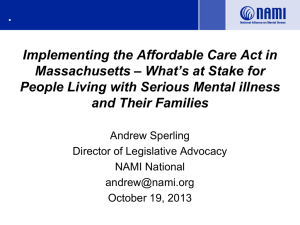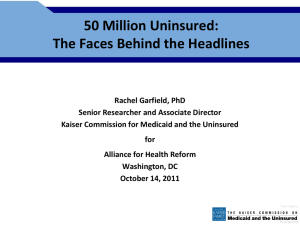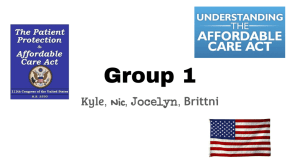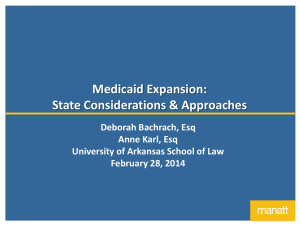Premium Tax Credits under the ACA
advertisement
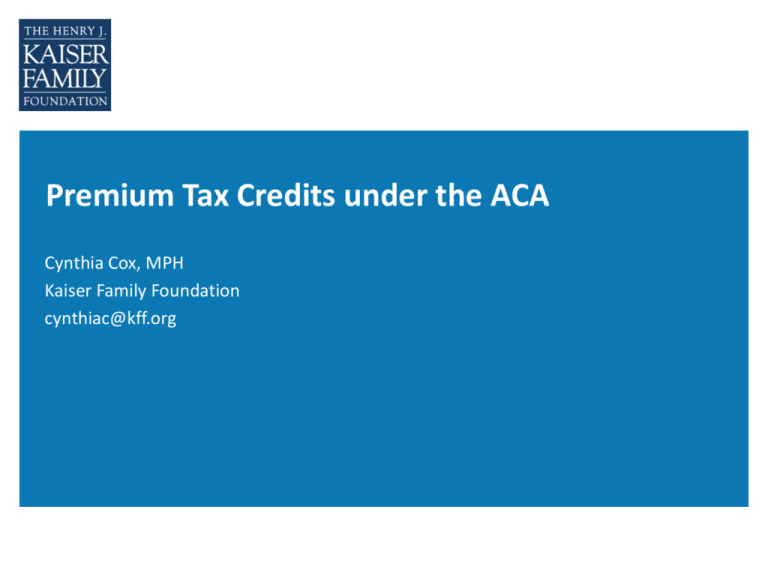
Premium Tax Credits under the ACA Cynthia Cox, MPH Kaiser Family Foundation cynthiac@kff.org Affordable Care Act Overview Key Elements of the Health Reform Law • Health insurance market reforms • Health insurance exchange • Subsidies for premiums • Expansion of public programs • Individual mandate • Employer requirements and incentives • Provisions for small employers • Delivery system reforms • “Shared responsibility” for financing Health Insurance Exchanges or Marketplaces • Individuals without other coverage and small employers will be able to purchase coverage through exchanges in 2014 • An estimated 27 million will enroll in coverage through these new exchanges by 2017 • Premium and cost-sharing subsidies available – Premium tax credits for eligible individuals and families with incomes 100-400% of poverty ($11,490 - $45,960 for an individual in 2013) who purchase coverage in exchanges – Cost sharing subsidies for those with incomes 100-250% FPL ($11,490 - $28,725 in 2013) to reduce out-of-pocket costs Estimated Health Insurance Coverage in 2017 Total Nonelderly Population = 279 million 10% Uninsured 16% Medicaid/CHIP 9% 8% Exchange Private Non-Group / Other 58% 56% Employersponsored Insurance Without Health Reform (56 Million Uninsured) With Health Reform (29 Million Uninsured) Uninsured Medicaid/CHIP Private NonGroup/Other Employersponsored Insurance 19% 13% 10% NOTE: This assumes that all states choose to expand Medicaid eligibility up to 138% FPL January 2014. SOURCE: Congressional Budget Office, February 2013. Total may not equal 100% due to rounding How People Get Covered… With and Without the Medicaid Expansion With Medicaid Expansion Without Medicaid Expansion Up to 100% of poverty Medicaid Unsubsidized 100-138% of poverty* Medicaid Exchange 138-400% of poverty Exchange Exchange >400% of poverty Unsubsidized (Can still purchase exchange coverage) Unsubsidized (Can still purchase exchange coverage) NOTES: Poverty Level is $11,170 for a single person and $23,050 for a family of four *Medicaid eligibility cut off is 133% FPL, however 5% of income is disregarded, making the threshold 138% FPL Health Insurance Marketplace will Facilitate Enrollment Into Coverage for those without Employer Offered Coverage Medicaid Premium Tax Credits Plan A Plan B Plan C John Doe 123 Main Street 12345 Unsubsidized Exchange Coverage Eligibility for Multiple Programs Determined in Real Time Information Provided on Available Plans for Comparison Enrollment Into Selected Plan Tax Credits and the Individual Mandate How the Individual Mandate Works • Most people required to have coverage through an employer, Medicaid or CHIP, Medicare, purchased individually, or other means or pay a penalty • Exemptions include: – Undocumented immigrants – Income below IRS filing threshold ($9,500 single, $19,000 married) – Health insurance (after employer contributions and tax credits) costs more than 8% of income • Penalty phases in 2014-2016 to greater of: – $695 per adult and $347.50 per child (up to $2,085 per family); or – 2.5% of family income Risk Pooling: An Illustrative Example = Healthy guys who use $100 in services = Sick guys who use $50,000 in services Average Risk Pool Average cost = $4,636 Risk Pool with Adverse Selection Average cost = $8,417 Adverse Selection: Subsidies Matter Adverse Selection Example: 25 year-old making $25,000 per year buying an insurance policy costing an average of $4,800 per year Community rating: Everyone pays $4,800 Unsubsidized, age-rated: 25 year-old pays $2,400 Exchanges: With tax credit, 25 year-old pays $1,700 11 How Many are Affected Per Year by the Individual Mandate? 32 million previously uninsured affected by the mandate 24 million qualify for exemptions from the mandate 219 million insured by employer coverage, Medicaid, Medicare’s disability coverage, or individual insurance and not affected by the mandate Projected Non-Elderly in 2016 = 275 million Source: Kaiser Family Foundation analysis; Congressional Budget Office; Jonathan Gruber How are tax credit calculated? 13 Source: UC Berkeley Labor Center, July 2013 Tax Credits set Caps on the Percent of Income Spent on Premiums, and Reduce Out of Pocket Costs for Some Income (Percent of Poverty) Premium Cap (Percent of Income) Cost Sharing Subsidies? (OOP Limit Individ/Fam) 0% - 100% FPL* No Cap (Unsubsidized) No ($6,350 / $12,700) 100% - 133% FPL* 2.0% Yes ($2,250 / $4,500) 133% - 150% 3.0%, phases out to 4.0% Yes ($2,250 / $4,500) 150% - 200% FPL 4.0%, phases out to 6.3% Yes ($2,250 / $4,500) 200% - 250% FPL 6.3%, phases out to 8.05% Yes ($5,200 / $10,400) 250% - 300% FPL 8.05%, phases out to 9.5% No 300% - 400% FPL 9.5% No Over 400% FPL No Cap (Unsubsidized) No * In states that expand Medicaid, everyone with incomes below 138% of the poverty level will qualify for Medicaid. In states that do not expand Medicaid, subsidies will be an option on for those with incomes above the poverty level. Tax Credits are Based on Silver Plans but can be Applied Toward Other Levels of Coverage Plan Type “Actuarial Value” Typical Deductible Coinsurance Maximum Out-ofPocket Cost Bronze 60% $5,000 30% $6,350 Silver 70% $2,000 20% $6,350 Gold 80% $0 20% $6,350 Platinum 90% $0 10% $6,350 Catastrophic (up to age 30) NA $6,350 0% $6,350 All figures are for single coverage. Amounts for families would be double. All plans have to cover a wide range of benefits. Subsidy Calculator 17 Subsidy Calculator Subsidy Calculator Premium Subsidy Examples (California Average) • Single 25 year old making $20,000 Unsubsidized silver premium = $2,772 Individual contribution = $1,021 Tax credit = $1,751 • 40 year old parents with two kids making $50,000 Unsubsidized silver premium = $10,563 Family contribution = $3,365 Tax credit = $7,198 • 60 year old couple making $50,000 Unsubsidized silver premium = $14,986 Family contribution = $4,750 Tax credit = $10,236 How will people get the tax credit? Outreach and Consumer Assistance Efforts in California • $43 million in outreach and education grants from Covered California. – Navigators will provide community-based outreach. – In-person assisters will help people apply for assistance, getting paid $58 per successful application. • $86 million in advertising from Covered California. • $225 million commitment from the California Endowment to support implementation of the ACA in California, with a particular focus on outreach. Income Verification • If Applicants estimate an increase in income: – Up to 10% higher • No additional verification – More than 10% higher • Additional verification, e.g. pay stub • Or self-attestation • If Applicants estimate an decrease in income: – Additional verification required – Rely on electronic data Maximum Repayment of Tax Credit Income (Percent of Poverty) Individual Family Up to 100% FPL No Repayment No Repayment 100% - 199% FPL $300 $600 200% - 299% FPL $750 $1,500 300% - 399% FPL $1,250 $2,500 400% FPL and up Entire amount of overpayment Entire amount of overpayment Opportunities and Challenges Looking Ahead • Historic opportunity to: expand coverage to tens of millions of uninsured Americans and make it more accessible. • Enrollment may be low at first. Effective outreach, especially to the young and healthy, is key to the ACA’s success. • Are people getting the help they need to understand new coverage options and enroll? • There will inevitably be technical glitches. It will matter how they are perceived, and whether they get fixed quickly. • What happens to the safety-net for those left out of expanded insurance? • Some people will be worse off as a result of reform, and will likely blame it on the ACA. Many people will be better off, and may or may not credit the ACA. • 2014 is not the end. Reform will keep getting reformed.

